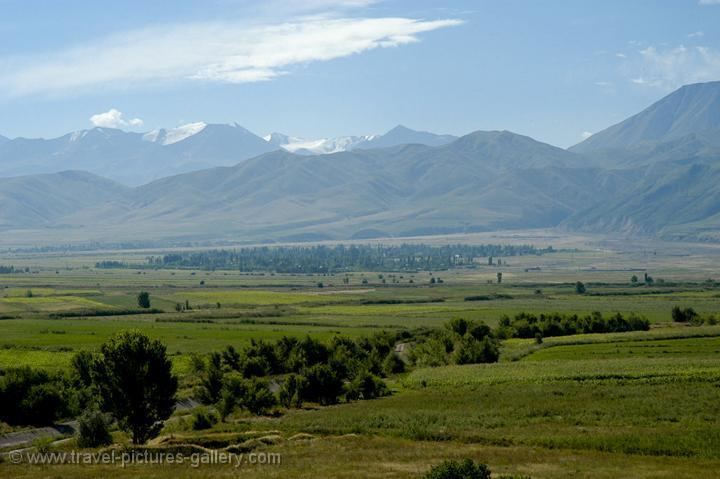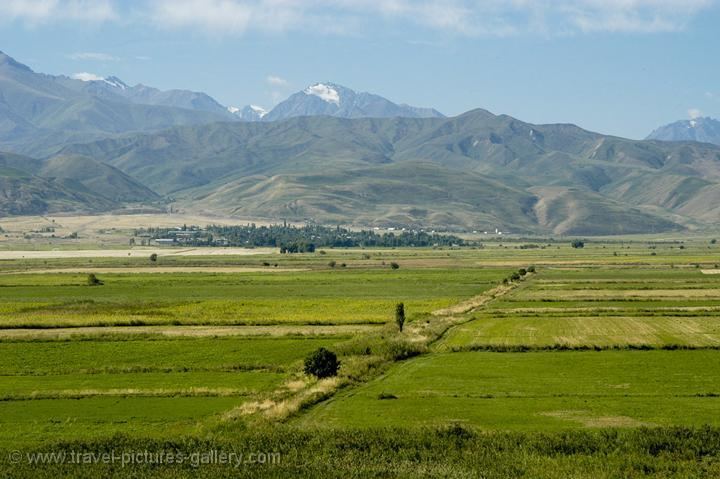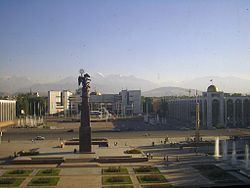Country Mayor Kubanychbek Kulmatov | Area 127 km2 Population 846,256 (2009) | |
 | ||
Points of interest Ala Archa National Park, Osh Bazaar, Burana Tower, Tash Rabat, Kyrgyz Ala-Too Range Colleges and Universities American University of Central Asia (Bishkek), Kyrgyz National University, International Atatürk-Alatoo University (Bishkek), International University of Kyrgyzstan, University of Central Asia (Bishkek) | ||
Map of Bishkek
Bishkek (Kyrgyz: Бишке́к, Bişkek, بىشکەک; [biʃˈkek]; Russian: Бишке́к, Biškék; [bʲɪʂˈkʲɛk]), formerly Pishpek and Frunze, is the capital and largest city of Kyrgyzstan (Kyrgyz Republic). Bishkek is also the administrative center of the Chuy Region. The province surrounds the city, although the city itself is not part of the province, but rather a province-level unit of Kyrgyzstan.
Contents
- Map of Bishkek
- Kyrgyzstan 2014 bishkek
- Open central asia book forum and literature festival bishkek kyrgyzstan 2012
- Kokhand rule
- Tsarist era
- Soviet Era
- Independence era
- Orientation
- City centre
- Outer neighbourhoods
- Outside the city
- Climate
- Demographics
- Air quality
- Economy
- Housing
- Government
- Administrative divisions
- Sports
- Education
- Mass public transport
- Commuter and long distance buses
- Rail
- Air
- Notable people
- In popular culture
- Twin towns and sister cities
- References

Post-Soviet research suggests the name derives from a Kyrgyz word for a churn used to make fermented mare's milk (kumis), the Kyrgyz national drink - although not all sources agree on this. In 1825 Khokand authorities established the fortress of "Pishpek" in order to control local caravan-routes and to collect tribute from Kyrgyz tribes. On 4 September 1860, with the approval of the Kyrgyz, Russian forces led by Colonel Zimmermann destroyed the fortress. In 1868 a Russian settlement was established on the site of the fortress under its original name, "Pishpek". It lay within the General Governorship of Russian Turkestan and its Semirechye Oblast.

In 1925 the Kara-Kirghiz Autonomous Oblast was established in Russian Turkestan, promoting Pishpek to its capital. In 1926 the Communist Party of the Soviet Union renamed the city as Frunze, after the Bolshevik military leader Mikhail Frunze (1885-1925), who was born there. In 1936, the city of Frunze became the capital of the Kirghiz Soviet Socialist Republic, during the final stages of the national delimitation in the Soviet Union.
In 1991 the Kyrgyz parliament changed the capital's name to "Bishkek".
Bishkek is situated at an altitude of about 800 meters (2,600 ft), just off the northern fringe of the Kyrgyz Ala-Too range, an extension of the Tian Shan mountain range. These mountains rise to a height of 4,855 meters (15,928 ft) and provide a spectacular backdrop to the city. North of the city, a fertile and gently undulating steppe extends far north into neighboring Kazakhstan. The Chui River drains most of the area. Bishkek is connected to the Turkestan-Siberia Railway by a spur line.
Bishkek is a city of wide boulevards and marble-faced public buildings combined with numerous Soviet-style apartment blocks surrounding interior courtyards. There are also thousands of smaller privately built houses - mostly outside the city center. Streets follow a grid pattern, with most flanked on both sides by narrow irrigation channels which water the innumerable trees that provide shade in the hot summers.
Kyrgyzstan 2014 bishkek
Open central asia book forum and literature festival bishkek kyrgyzstan 2012
Kokhand rule
Originally a caravan rest stop (possibly founded by the Sogdians) on one of the branches of the Silk Road through the Tian Shan range, the location was fortified in 1825 by the Uzbek khan of Kokhand with a mud fort. In the last years of Kokhand rule, the fortress was led by Atabek, the Datka.
Tsarist era
In 1860, the fort was conquered and razed by the military forces of Colonel Zimmermann when Tsarist Russia annexed the area. Colonel Zimmermann rebuilt the town over the destroyed fort and put field Poruchik Titov as head of a new Russian garrison. The site was redeveloped from 1877 onward by the Russian government, which encouraged the settlement of Russian peasants by giving them fertile land to develop.
Soviet Era
In 1926, the city became the capital of the newly established Kirghiz ASSR and was renamed "Frunze" after Mikhail Frunze, Lenin's close associate who was born in Bishkek and played key roles during the revolutions of 1905 and 1917 and during the Russian civil war of the early 1920s.
Independence era
The early 1990s were tumultuous. In June 1990, a state of emergency was declared following severe ethnic riots in southern Kyrgyzstan that threatened to spread to the capital. The city was renamed Bishkek on 5 February 1991 and Kyrgyzstan achieved independence later that year during the breakup of the Soviet Union. Before independence, the majority of Bishkek's population were ethnic Russians. In 2004, Russians made up approximately 20% of the city's population, and about 7–8% in 2011.
Today, Bishkek is a modern city with many restaurants and cafes, and with many second-hand European and Japanese cars and minibuses crowding its streets. However, streets and sidewalks have fallen into disrepair since the 1990s. At the same time, Bishkek still preserves its former Soviet feel with Soviet-period buildings and gardens prevailing over newer structures.
Bishkek is also the country's financial center, with all of the country's 21 commercial banks headquartered there. During the Soviet era, the city was home to a large number of industrial plants, but most have been shut down since 1991 or now operate on a much reduced scale. One of Bishkek's largest employment centers today is the Dordoy Bazaar open market, where many of the Chinese goods imported to CIS countries are sold.
Orientation
Though the city is relatively young, the surrounding area has some sites of interest dating to prehistorical times. There are also sites from the Greco-Buddhist period, the period of Nestorian influence, the era of the Central Asian khanates, and the Soviet period.
The central part of the city is laid out on a rectangular grid plan. The city's main street is the east–west Chui Avenue (Chuy Prospekti), named after the region's main river. In the Soviet era, it was called Lenin Avenue. Along or near it are many of the most important government buildings and universities. These include the Academy of Sciences compound. The westernmost section of the avenue is known as Deng Xiaoping Avenue.
The main north–south street is Yusup Abdrakhmanov Street, still commonly referred to by its old name, Sovietskaya Street. Its northern and southern sections are called, respectively, Yelebesov and Baityk Batyr Streets. Several major shopping centers are located along it, and in the north it provides access to Dordoy Bazaar.
Erkindik ("Freedom") Boulevard runs from north to south, from the main railroad station (Bishkek II) south of Chui Avenue to the museum quarter and sculpture park just north of Chui Avenue, and further north toward the Ministry of Foreign Affairs. In the past it was called Dzerzhinsky Boulevard, named after a Communist revolutionary, Felix Dzerzhinsky, and its northern continuation is still called Dzerzhinsky Street.
An important east–west street is Jibek Jolu ('Silk Road'). It runs parallel to Chui Avenue about 2 km (1 mi) north of it, and is part of the main east–west road of Chui Province. Both the eastern and western bus terminals are located along Jibek Jolu.
There is a Roman Catholic church located at ul. Vasiljeva 197 (near Rynok Bayat). It is the only Catholic cathedral in Kyrgyzstan.
City centre
Outer neighbourhoods
The Dordoy Bazaar, just inside the bypass highway on the north-eastern edge of the city, is a major retail and wholesale market.
Outside the city
The Kyrgyz Ala-Too mountain range, some 40 kilometres (25 mi) away, provides a spectacular backdrop to the city; the Ala Archa National Park is only a 30 to 45 minutes drive away.
Climate
Bishkek has a dry summer continental climate (Köppen climate classification Dsa). Average precipitation is around 440 millimetres (17 in) per year. Average daily high temperatures range from 3 °C (37.4 °F) in January to about 31 °C (87.8 °F) during July. The summer months are dominated by dry periods, punctuated by the occasional thunderstorm, which produces strong gusty winds and rare dust storms. The mountains to the south provide a natural boundary and protection from much of the damaging weather, as does the smaller mountain chain which runs north-west to south-east. In the winter months, sparse snow storms and frequent heavy fog are the dominating features. There are sometimes temperature inversions, during which the fog can last for days at a time.
Demographics
Bishkek is the most populated city in Kyrgyzstan. Its population, estimated in 2015, was 937,400. From the foundation of the city to the mid-1990s, ethnic Russians and other peoples of European descent (Ukrainians, Tatars, Germans) comprised the majority of the city's population. According to the 1970 census, the ethnic Kyrgyz were only 12.3%, while whites were more than 80% of Frunze population. Now Bishkek is a predominantly Kyrgyz city, with around 66% of its residents Kyrgyz, while European peoples make up less than 20% of the population. Despite this fact, Russian is the main language while Kyrgyz continues losing ground especially among the younger generations
Air quality
Emissions of air pollutants in Bishkek amounted to 14,400 tons in 2010. Among all cities in Kyrgyzstan, the level of air pollution in Bishkek is the highest, occasionally exceeding maximum allowable concentrations by several times, especially in the city center. For example, concentrations of formaldehyde occasionally exceed maximum allowable limits by a factor of four.
Responsibility for ambient air quality monitoring in Bishkek lies with the Kyrgyz State Agency of Hydrometeorology. There are seven air quality monitoring stations in Bishkek, measuring levels of sulfur dioxide, nitrogen oxides, formaldehyde, and ammonia.
Economy
Bishkek uses the Kyrgyzstan currency, the som. The som's value fluctuates regularly, but averaged around 61 som per U.S. dollar as of February 2015. The economy in Bishkek is primarily agricultural, and agricultural products are sometimes bartered in the outlying regions. The streets of Bishkek are regularly lined with produce vendors in a market style venue. In most of the downtown area there is a more urban cityscape with banks, stores, markets and malls. Sought after goods include hand-crafted artisan pieces, such as statues, carvings, paintings and many nature-based sculptures.
Housing
As with many cities in Post-Soviet states, housing in Bishkek has undergone extensive changes since the collapse of the Soviet Union. While housing was formerly distributed to citizens in the Soviet-era, housing in Bishkek has since become privatized.
Though single family houses are slowly becoming more popular, the majority of the residents live in Soviet-era apartments. Despite the Kyrgyz economy experiencing growth, increases in available housing has been slow with very little new construction. As a result of this growing prosperity and the lack of new formal housing, prices has been rising significantly - doubling from 2001 to 2002.
Those unable to afford the high price of housing within Bishkek, notably internal migrants from rural villages and small provincial towns often have to resort to informal squatter settlements on the outskirts of the city. These settlements are estimated to house 400,000 people or about 30 percent of Bishkek’s population. While many of the settlements have lacked basic necessities such as electricity and running water, recently there has been a push by the local government to provide these services.
Government
Local government is administered by the Bishkek Mayor's Office. Askarbek Salymbekov was mayor until his resignation in August 2005, after which his deputy, Arstanbek Nogoev, took over the mayorship. Nogoev was in turn removed from his position in October 2007 through a decree of President Kurmanbek Bakiyev and replaced by businessman and former first deputy prime minister Daniar Usenov. In July 2008 former head of the Kyrgyz Railways Nariman Tuleyev was appointed mayor, who was dismissed by the interim government after 7 April 2010. From April 2010 to February 2011 Isa Omurkulov, also a former head of the Kyrgyz Railways, was an interim mayor, and from 4 February 2011 to 14 December 2013 he was re-elected the mayor of Bishkek. Kubanychbek Kulmatov was nominated for election by parliamentary group of Social Democratic Party of Kyrgyzstan in city kenesh, and he was elected as a new mayor on 15 January 2014, and stepped down on 9 February 2016 The new major Albek Sabirbekovich Ibraimov was also nominated for election by parliamentary group of Social Democratic Party of Kyrgyzstan in city kenesh, and he was elected by Bishkek City Kenesh on 27 February 2016.
Administrative divisions
Bishkek city covers 169.6 square kilometres (65.5 square miles) and is administered separately and not part of any region. Besides the city proper, one urban-type settlement and one village are administered by the city: Chong-Aryk and Orto-Say. The city is divided into 4 districts: Birinchi May, Lenin, Oktyabr and Sverdlov. Chong-Aryk and Orto-Say are part of Lenin District.
Sports
Bishkek is home to Spartak, the biggest football stadium in Kyrgyzstan and the only one eligible to host international matches. Several Bishkek-based football teams play on this pitch, including six-time Kyrgyzstan League champions, Dordoi-Dynamo.
Bishkek hosted the 2014 IIHF Challenge Cup of Asia – Division I.
Education
Educational institutions in Bishkek include:
In addition, the following international schools serve the expatriate community in Bishkek:
Mass public transport
Public transportation includes buses, electric trolley buses, and public vans (known in Russian as marshrutka). The first bus and trolley bus services in Bishkek were introduced in 1934 and 1951, respectively.
Taxi cabs can be found throughout the city.
There is no subway in Bishkek, but the city is considering designing and building a light rail system (Russian: Бишкекское лёгкое метро).
Commuter and long-distance buses
There are two main bus stations in Bishkek. The smaller old Eastern Bus Station is primarily the terminal for minibuses to various destinations within or just beyond the eastern suburbs, such as Kant, Tokmok, Kemin, Issyk Ata, or the Korday border crossing.
Long-distance regular bus and minibus services to all parts of the country, as well as to Almaty (the largest city in neighboring Kazakhstan) and Kashgar, China, run mostly from the newer grand Western Bus Station; only a smaller number run from the Eastern Station.
The Dordoy Bazaar on the north-eastern outskirts of the city also contains makeshift terminals for frequent minibuses to suburban towns in all directions (from Sokuluk in the west to Tokmak in the east) and to some buses taking traders to Kazakhstan and Siberia.
Rail
As of 2007, the Bishkek railway station sees only a few trains a day. It offers a popular three-day train service from Bishkek to Moscow.
There are also long-distance trains that leave for Siberia (Novosibirsk and Novokuznetsk), via Almaty, over the Turksib route, and to Yekaterinburg (Sverdlovsk) in the Urals, via Astana. These services are remarkably slow (over 48 hours to Yekaterinburg), due to long stops at the border and the indirect route (the trains first have to go west for more than a 100 kilometres (62 mi) before they enter the main Turksib line and can continue to the east or north). For example, as of the fall of 2008, train No. 305 Bishkek-Yekaterinburg was scheduled to take 11 hours to reach the Shu junction—a distance of some 269 kilometres (167 mi) by rail, and less than half of that by road.
Air
The city is served by Manas International Airport (IATA code FRU), located approximately 25 kilometres (16 mi) northwest of the city centre, and readily reachable by taxi.
In 2002, the United States obtained the right to use Manas International Airport as an air base for its military operations in Afghanistan and Iraq. Russia subsequently (2003) established an air base of its own (Kant Air Base) near Kant, some 20 kilometres (12 mi) east of Bishkek. It is based at a facility that used to be home to a major Soviet military pilot training school; one of its students, Hosni Mubarak, later became president of Egypt.
Notable people
In popular culture
In the video game Command & Conquer: Generals, GLA forces held this city, capital of a unified Kyrgyzstan and Tajikistan. They reinforced their forces by railways connected to other areas and locals enraged at the Chinese presence in the area. Black Lotus and her strike team had to destroy the bridge and a sports stadium before they were overrun. Due to the nature of the mission, a covert operation, they were reduced to minimal strength.
Twin towns and sister cities
Sister cities of Bishkek include:
